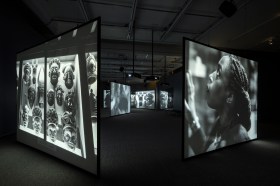For some people, a future where AI dominates their lives is a world they would rather not see.
Many of us worry that AI is giving tech lords unprecedented power and making ordinary people the pawns within their intensely manipulative systems.
While some high-profile tech experts see these semi-dystopian scenarios as being already here (and that genie cannot be put back in its bottle now), many others are instead advocating for AI as a force for good, and as something with the power to aid humanity and solve some of the world’s most pressing concerns.
In the arts and cultural context, the institutions with the most power to help build humanity’s knowledge are our major museums and galleries. As the largest players in the room, they are the ones with the most extensive collections and valuable information in their hands.
According to Stanford University’s latest AI Index Report – released two months ago – the world’s major cultural institutions are among those with the most to gain from AI’s increasing power to work with large data sets (also known as Large Language Models, or LLMs) to make their collections more accessible and offer richer experiences to audiences around the world.
Imagine, if you will, a search of your favourite museum’s digital database which not only allows you to bring up one of your favourite paintings in their collection, but when you do, the search automatically recognises that painting’s use of a particular colour or a special artistic technique, and prompts you to click further links to discover more about these qualities, thus exponentially expanding your knowledge in this field in a targeted and effective way.
This example illustrates the kind of scenario tech experts say will become as routine as our use of GPS on our smartphones today – it will soon be taken for granted, and seen as part and parcel of audiences’ engagement with their tech systems – in this case, their online experience of whichever state museum website or app they are using.
Read: Human artist beats AI, but it’s coming back with a vengeance
And while the big tech companies can’t wait to get started on this road to the future, for museums, the decisions around how to proceed in this AI space are more complicated, requiring measured thought.
AI opportunities and threats on the horizon
An Australian museum leading the charge in the AI-space is ACMI (Australian Centre for the Moving Image).
ACMI’s Head of Technology Jeff Williams says, ‘It’s an exciting time because the technology has come a long way from where it was in, say 2017, when ACMI had AI ideas it wanted to pursue, but the tech wasn’t there,’ he tells ArtsHub.
‘But now that more [AI] tools are available, we have been able to build our own assets and data-sets, and that’s helping us create some very important accessibility tools for our audiences.’
By way of example, Williams cites an ACMI AI project underway that is creating labels for its exhibitions which could then be translated into any language via a smartphone. Innovative advanced search options for ACMI’s online collection, which are already active and allow website users to search via video content and audio descriptions, are another example he references.
But Williams says these AI advancements do not come cheap, and he sees the costs burden as one of the major challenges for museums moving into the AI space.
‘Even ACMI doesn’t have a huge amount of resourcing for this stuff. We have to be super resourceful with how we do this. And I think that is one big challenge for the arts and cultural sector. We just don’t attract the same levels of investment in AI as in some other fields.’
Williams points to some remarkable AI-led breakthroughs in the medical field, underpinned by high-level government and private sector investment, as practical examples. Unfortunately, he says, the same scale of AI investment is not happening in the arts and cultural space.
‘So, we [in the arts] have to try to do more of it ourselves, which makes it harder,’ he says.
But Williams is far from defeated in his outlook. Instead, he thinks major museums have a responsibility to engage ethically with AI and do more to set examples for others to follow.
‘We have our own in-house developers, which has been a very good way to go,’ he says, adding that ‘the last thing a major museum wants to do is sign a deal with a [third party] tech company, and find they have lost control of the use of their collections’ data’.
Williams continues: ‘So, that’s one big risk museums need to be aware of. They must realise how important it is to retain control of their information.’
Will complex information get lost in AI translation?
Aside from the threat of big tech usurping museums’ right to their own collections, Williams says museums must also recognise the risks posed by badly designed AI systems which could misconstrue their content, or corrupt it with unintended biases and errors.
He explains that when crudely designed AI-systems repurpose and synthesise data, they can gloss over crucial nuances that give that data its true meaning. (An example might be seeing the human uttered phrase ‘I’m going out for milk’ summarised by AI as describing someone going out to milk cows, rather than going out to buy milk from a shop.)
Williams cautions, ‘These AI systems don’t know the history of your organisation, and they can’t achieve advanced thought, so there are risks there around a lack of proper contextualisation of information.
‘This is also something museums will have to manage very carefully.’
Ensuring smaller museums can keep up with AI
A final risk high on the radar of ACMI’s AI team has little to do with how museums design their AI-led systems, and more to do with who will have the privilege of accessing this technology.
As ACMI’s Director and CEO Seb Chan sees it, as we move forward we are likely to see a future where the larger cultural institutions will hold most, if not all, of the power with AI technologies. Smaller (also remote and regional) museums are likely to be left out.
In addition to leading ACMI, Chan is also National Council President of the Australian Museums and Galleries Association (AMaGA). He says his most pressing concerns about museums and AI have arisen thanks to the sector-wide view required in his AMaGA role.
‘Speaking with my AMaGA hat on, I worry there is going to be an unevenness across the sector based on the size [of institutions],’ Chan tells ArtsHub.
‘We know our smaller and regionally-located cultural institutions already lack resources compared to the major institutions. And the development of AI systems require significant financial investment and increased computational power.’
Chan therefore see it as essential that major cultural organisations collaborate with the smaller players to ensure digital equity in the long term.
‘If you think about it, the majority of public museums and galleries in this country are small, local government-supported, often regional organisations,’ he explains.
‘We know these smaller organisations have no capacity to develop AI systems on their own. It will take assistance from the larger institutions. So, we need to be thinking about incentivising the major national and state institutions to assist the smaller museums.
‘We can’t expect the smaller museums to offer audiences the same level of digital access as the majors necessarily,’ Chan continues. ‘But they cannot be left behind entirely.’
Switching hats to speak again as ACMI’s CEO, Chan reveals that fair and equitable AI access is high on the minds of his team as they continue to progress their own systems.
‘We think it’s important for us to be very public and transparent with [AI] processes,’ Chan says.
‘We also want to help other cultural institutions understand the value of what they currently have, and what it’s going to take to develop some of these new systems.’





